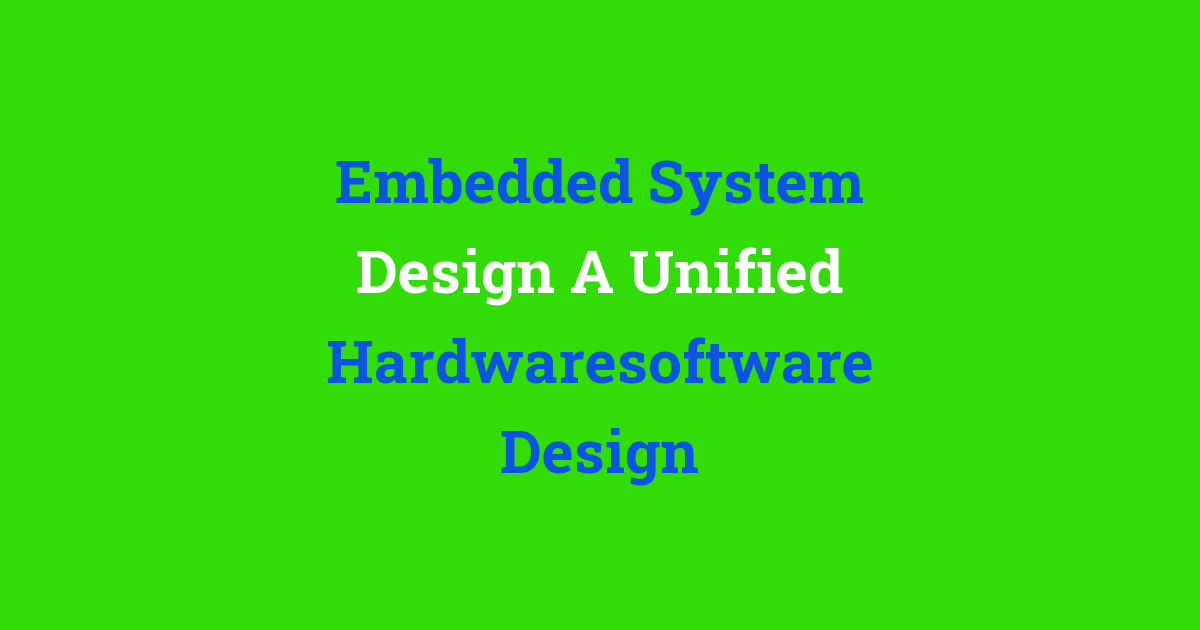Designing a unified hardware-software design for an embedded system.
Embedded System Design: A Unified Hardware-Software Approach
Introduction
In the field of engineering, embedded systems play a crucial role in the development of innovative technologies. These systems are designed to perform specific tasks within a larger system, making them an essential component in various industries. One of the key challenges in embedded system design is the integration of hardware and software components. Traditionally, these two elements have been developed separately, leading to inefficiencies in the overall system performance. In this project, we aim to explore the concept of unified hardware-software design in embedded systems to address this issue.
Problem Statement
The traditional approach to embedded system design involves the separate development of hardware and software components. This siloed approach often leads to compatibility issues, performance bottlenecks, and increased development time and cost. Additionally, it can be challenging to optimize the system as a whole when hardware and software are developed independently. There is a need for a unified hardware-software design approach that can streamline the development process, improve system performance, and facilitate easier integration of components.
Existing System
In the existing system, hardware and software components are developed separately. Hardware designers focus on designing the physical components of the system, such as processors, memory, and peripherals, while software developers write code to control these components and perform specific tasks. The integration of hardware and software is typically done at a later stage, which can lead to compatibility issues and inefficiencies in the system.
Disadvantages
There are several disadvantages to the traditional approach of separate hardware and software development in embedded systems. These include:
1. Compatibility issues: Developing hardware and software independently can lead to compatibility issues that are difficult to resolve.
2. Performance bottlenecks: The lack of integration between hardware and software components can result in performance bottlenecks and inefficiencies in the system.
3. Increased development time and cost: Developing hardware and software components separately can lead to longer development times and increased costs.
4. Difficulty in optimizing the system: It can be challenging to optimize the system as a whole when hardware and software components are developed independently.
Proposed System
The proposed system involves a unified hardware-software design approach in embedded systems. In this approach, hardware and software components are developed concurrently, with a focus on seamless integration and optimization of the system as a whole. By bringing hardware and software developers together early in the design process, we can ensure better compatibility, improved performance, and reduced development time and cost.
Advantages
The unified hardware-software design approach offers several advantages over the traditional separate development approach. These include:
1. Better compatibility: By developing hardware and software components concurrently, we can ensure better compatibility and seamless integration of the system.
2. Improved performance: The unified design approach allows for optimization of the system as a whole, leading to improved performance and efficiency.
3. Reduced development time and cost: By streamlining the development process and eliminating the need for separate hardware and software development cycles, we can reduce development time and cost.
4. Easier system optimization: The unified design approach makes it easier to optimize the system as a whole, leading to better overall performance and efficiency.
Features
Some key features of the proposed unified hardware-software design approach in embedded systems include:
1. Concurrent development of hardware and software components
2. Seamless integration and optimization of the system
3. Early collaboration between hardware and software developers
4. Improved compatibility and performance
5. Reduced development time and cost
Conclusion
In conclusion, the unified hardware-software design approach offers a promising solution to the challenges faced in traditional embedded system design. By bringing hardware and software developers together early in the design process, we can ensure better compatibility, improved performance, and reduced development time and cost. The proposed system has the potential to streamline the development process, optimize system performance, and facilitate easier integration of components. Overall, the unified hardware-software design approach represents a significant advancement in embedded system design that has the potential to revolutionize the field of engineering.

